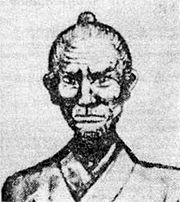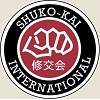
Matsumura Sōkon was one of the original karate masters of Okinawa. His life is reported variously as (c.1809-1901) or (1798-1890) or (1809-1896) or (1800-1892)
Matsumura Sōkon was born in Yamagawa Village, Shuri, Okinawa. Matsumura began the study of karate under the guidance of Sakukawa Kanga (1762-1843) or (1733-1815) or (1782-1837). Sakukawa was an old man at the time and reluctant to teach the young Matsumura, who was regarded as something of a troublemaker. However, Sakukawa had promised Matsumura Sōfuku, Matsumura Sōkon’s father, that he would teach the boy, and thus he did. Matsumura spent five years studying under Sakukawa. As a young man, Matsumura had already garnered a reputation as an expert in the martial arts.
Matsumura was recruited into the service of the Shō family, the royal family of the Ryūkyū Kingdom in 1816 and received the title Shikudon, a gentry rank. He began his career by serving the 17th King of Ryūkyū's second Shō dynasty, King Shō Kō. In 1818 he married Yonamine Chiru, who was a martial arts expert as well. Matsumura eventually became the chief martial arts instructor and bodyguard for the Okinawan King Shō Kō. He subsequently served in this capacity for the last two Okinawan kings, Shō Iku and Shō Tai. Matsumura traveled on behalf of the royal government to Fuzhou and Satsuma. He studied Chuan Fa in China as well as other martial arts and brought what he learned back to Okinawa.
Matsumura is credited with passing on the Shōrin-ryū Kempō-karate kata known as naihanchi I & II, passai, seisan, chintō, gojūshiho, kusanku (the embodiment of kusanku's teaching as passed on to Tode Sakugawa) and hakutsuru. The hakutsuru kata contains the elements of the Fujian White Crane system taught within the Shaolin system of Chinese kempō. Another set of kata, known as chanan in Matsumura's time, is said to have been devised by Matsumura himself and was the basis for pinan I and II. Matsumura's style has endured to the present day and the above mentioned kata are the core of Shōrin-ryū karate today.
Matsumura was given the title "bushi" meaning "warrior" by the Okinawan king in recognition of his abilities and accomplishments in the martial arts. Described by Gichin Funakoshi as a sensei with a terrifying presence, Matsumura was never defeated in a duel, though he fought many. Tall, thin, and possessing a pair of unsettling eyes, Matsumura was described by his student Ankō Itosu as blindingly fast and deceptively strong. His martial arts endeavors have been the progenitor of many contemporary karate styles: Shōrin-ryū, Shotokan, and Shitō-ryū, for example. Ultimately, all modern styles of karate that evolved from the Shuri-te lineage can be traced back to the teachings of Bushi Matsumura. Of note, his grandson was the modern Tōde master, Tsuyoshi Chitose, who assisted Gichin Funakoshi in the early introduction and teaching of karate in Japan and who founded the Chitō-ryū style.
